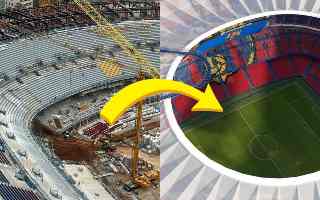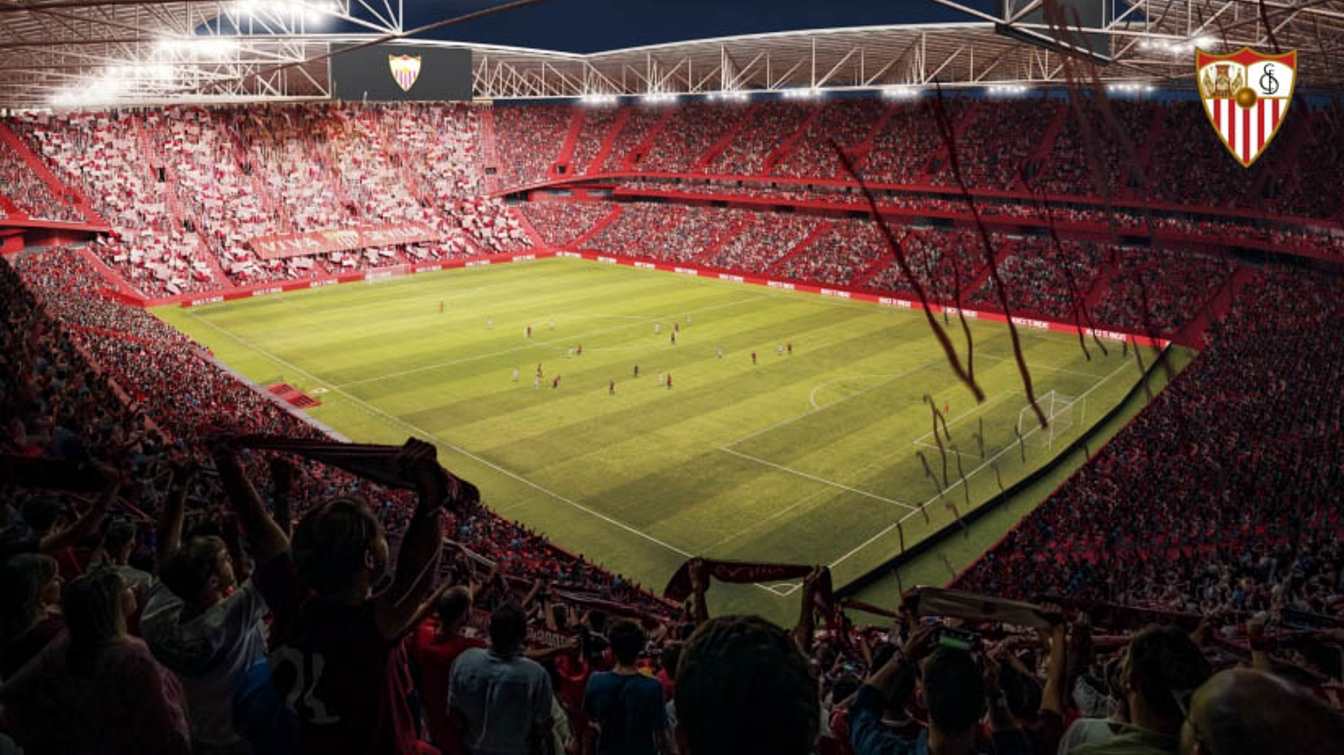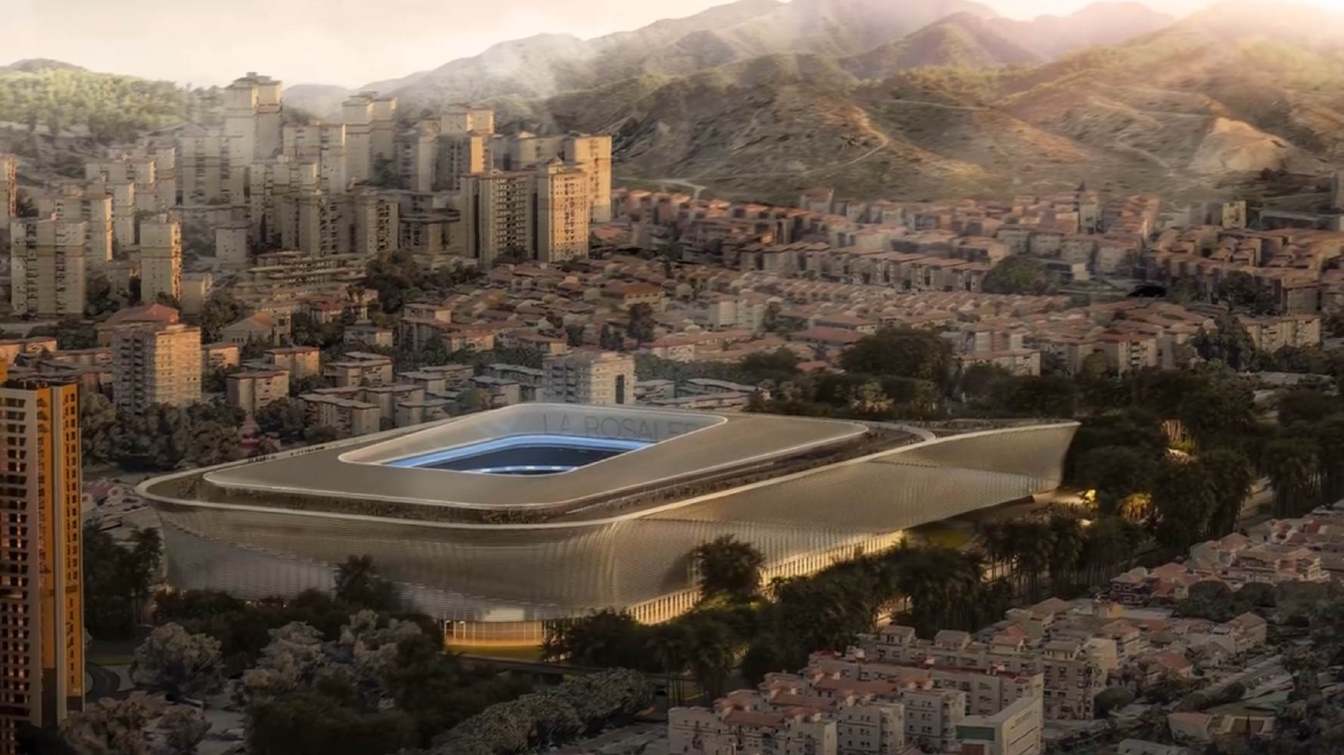Spain: Wave of stadium upgrades sweeps through the Iberian Peninsula
source: StadiumDB.com; author: Miguel Ciołczyk Garcia
 In recent years, work on Spanish stadiums has not stopped, and the 2030 World Cup has provided another important impetus for the renovation of facilities. With work on the Bernabéu, Camp Nou and Balaídos already underway, 9 La Liga venues are awaiting their turn. Rosaleda, Romareda, Riazor and La Cartuja join the group as 2030 World Cup hosts.
In recent years, work on Spanish stadiums has not stopped, and the 2030 World Cup has provided another important impetus for the renovation of facilities. With work on the Bernabéu, Camp Nou and Balaídos already underway, 9 La Liga venues are awaiting their turn. Rosaleda, Romareda, Riazor and La Cartuja join the group as 2030 World Cup hosts.
Advertisement
Wave of modernisations
News of the planned and ongoing renovations of venues is coming from Spain non-stop. The Camp Nou redevelopment in Barcelona and the Santiago Bernabéu works in Madrid are, of course, getting most of the attention, but there is no shortage of further news about almost every and each venue of Primera División.
Back in May 2023, the head of LaLiga's Clubs Bureau, Jaime Blanco, announced that around 40% of Primera and Segunda Division venues would undergo a transformation
over the next two to five years, with the aim of reaching new audiences, further increasing revenues and transforming football hubs into key points on the local map.
Jaime Blanco also noted that projects involving exponential increases in stadium capacity are a thing of the past,
instead adjusting to reality by attracting audiences with quality of experience and a wide range of offerings beyond the match day. As he points out, this is a new approach and will certainly not be easy to implement.
Bernabéu, Camp Nou and... Balaídos
Santiago Bernabéu, Camp Nou and Abanca Balaídos are the three Primera stadiums currently undergoing modernisation, although the situation of each is different. Bernabéu is in the final phase of its reconstruction and the media have been speculating for some time about when its inauguration will be announced. Although it does have its problems, such as neighbourhood complaints about noise from concerts, Los Blancos’ temple has been named the best stadium in the world by the World Football Summit.
Camp Nou, on the other hand, is halfway to completion, which is expected to be in September 2026. Now, construction company Limak and Barça are focused on returning to their home as soon as possible, with a capacity of 60% of the planned capacity and two years of work ahead of them. Once completed, the new Camp Nou will be the largest stadium in Europe.
Balaídos is currently preparing for the fourth and final phase of the redevelopment, which has been underway tier by tier since 2015. Work on the Gol stand is scheduled to begin in January 2025. With its completion, scheduled for summer 2027, Celta's stadium will have a uniform look, with a light blue facade and roof reminiscent of the waves of the Atlantic Ocean. However, both Celta and the Vigo City Council are already thinking about the next renovation of the municipal stadium.
This is the list of stadiums under construction:
| Stadium | Club | Expected renovation duration | Capacity after renovation | Cost |
|---|---|---|---|---|
| Spotify Camp Nou | FC Barcelona | 2022-2026 | 105,953 | €1.07b |
| Santiago Bernabéu | Real Madrid | 2019-2024 | 84,744 | €1.17b |
| La Cartuja | - | 2024-2025 | 75,000 | €12m |
| Nueva Romareda | Real Zaragoza | 2024-2027 | 42,500 | €140m |
| Abanca Balaídos | Celta Vigo | 2015-2027 | 28,000 | €50m |
The trio from Seville
The Andalusian capital is undoubtedly the city with the brightest future in terms of new projects. Not only do Betis and Sevilla want to modernise their stadiums, but also the first phase of the reconstruction of La Cartuja is already underway to make it suitable for the 2030 World Cup. After lowering the pitch by 5 metres, the stadium's capacity will be increased to 75,000 fans, making it the third largest stadium in Spain, behind only the Camp Nou and the Bernabéu.
Once the modernization of La Cartuja is completed, work on the new Benito Villamarín will begin, as Betis will have to move to the Olympic Stadium for a while. This is expected to be in April 2025. However, the Verdiblancos have to overcome a number of problems before pushing ahead with their project. Neighbours in the Heliópolis neighbourhood fear that Betis' home will become a second Bernabéu,
while opposition politicians and environmentalists have accused it of being an environmental threat and a legal loophole.
A year after Betis, Sevilla F.C. will also move to La Cartuja due to the reconstruction of their own venue, implementing the new Ramon Sanchez Pizjuan project by IDOM. The works, which will take about two years, will increase the stadium's capacity to 55,000 spectators. A complete roof will also be built, and the north stand will be on a single level.
 © Sevilla FC, IDOM | Design of Nuevo Ramón Sánchez-Pizjuán
© Sevilla FC, IDOM | Design of Nuevo Ramón Sánchez-Pizjuán
The works that don’t start
Valencia and Valladolid are the scenes of two stalled projects. Nou Mestalla works have been paralysed for more than 15 years, although the club has recently initiated the most serious attempt to unblock them in a long time. Valencia is now working flat out to present the modified stadium project, and if approved, the machines will return to the site of the abandoned concrete skeleton by 12 January, and they will have 30 months to finish the Nou Mestalla.
Meanwhile, Estadio José Zorrilla is still waiting for the promised modernisation project. The facelift carried out this summer is clearly insufficient, and the opposition accuses Valladolid City Council of delaying the start of proceedings after rejecting the project that was pre-agreed by Real Valladolid and the previous administration.
The 2030 World Cup boost
Estadio Gran Canaria is the only Primera División stadium whose renovation is due to Spain's 2030 World Cup bid, but it is accompanied by three historic stadiums that currently host Segunda matches. These are, of course, La Romareda, La Rosaleda and Abanca-Riazor, all of them listed in the Bid Book
of the joint candidature of Spain, Portugal and Morocco to host the 2030 World Cup.
Spain's biggest renovation boom to date occurred just prior to the 1982 World Cup. It was then that the Benito Villamarín, San Mamés Barria, Estadio Santiago Bernabéu and Estadio Ramón Sánchez-Pizjuán stadiums, among others, underwent thorough serious modernisation.
Now, the Nueva Romareda project is already underway. The demolition of the stands has begun and will be completed in October 2025. By then, Real Zaragoza, who for now continue to play in the stadium, will have to move to the modular stadium in the Parking Norte. The works are expected to be finished in summer 2027, so that Zaragoza can start the 2027/28 season in its new stadium, with a capacity of 42,500 spectators, a roof fully covering the stands and a futuristic façade.
 © IDOM | Design of Nueva Romareda
© IDOM | Design of Nueva Romareda
The home of Las Palmas will undergo a refurbishment estimated to cost €107m. The new Estadio Gran Canaria project, which includes a roof covering all the stands, a capacity expansion and an aesthetic façade, was the key to the stadium being chosen as a World Cup venue, as it initially seemed unlikely that the island stadium would be on the shortlist.
Meanwhile, Deportivo de la Coruña continues to have doubts about the remodelling of Riazor, especially because of the possibility of having to play with a much reduced capacity due to the works. If successful, the project will give Galicia's largest stadium a modern look and almost 16,000 more seats, bringing the capacity to 48,000 fans.
The project to modernise La Rosaleda foresees an increase in seating capacity similar to that of Riazor, going from the current 30,000 to the 45,000 required by FIFA. The aim is to turn the Boquerones' temple into one of the most modern stadiums in Spain, including a hotel, for which the Malaga authorities have a budget of €260m.
 © Junta de Andalucía | Design of Estadio La Rosaleda
© Junta de Andalucía | Design of Estadio La Rosaleda
The small ones that aspire to be big(ger)
Getafe, Leganés and Girona aspire to remodel their stadiums, which are among the smallest in La Liga. Azulones' project, however, does not focus on increasing the capacity, but on modernising the facility, giving it a new façade and a complete roof. This is a sensible approach, especially considering that last season the capacity of the Coliseum was more than enough for Getafe fans, who filled it to 68%, which was the worst result among all Primera Liga grounds.
Girona's problem is, on the contrary, that the capacity of Estadi Montilivi is much lower than desired, especially after the phenomenal season of Michel's team. Paradoxically, the problem is aggravated by the historic debut in the Champions League, as due to the fact that UEFA prohibits retractable stands, the capacity of Montilivi is not 14,624, but 9,282 seats. Although nothing has been yet announced, nobody doubts that Montilivi needs an extension, and even Blanc-i-vermells fan Javier Caireta-Serra presented on the social media earlier this year his own project for an extension of the stadium to 20,000 seats, which quickly went viral.
Estadio Municipal Butarque also needs a modernization. Club president Jeff Lunhnow had spoken in an interview with Óscar Egido at the end of last season about roofing the stadium and expanding its capacity using CVC funds. However, only minor changes were made over the summer to bring the stadium up to First Division standards, and the fans are still waiting for the announcement of a project to refurbish the facilities.
This is the list of projects awaiting implementation:
| Stadium | Club | Expected renovation duration | Capacity after renovation | Cost |
|---|---|---|---|---|
| Benito Villamarín | Real Betis | 2025-2027 | 60,379 | €70 mln |
| Nuevo Ramón Sánchez-Pizjuán | Sevilla FC | 2026-2028 | 55,000 | €300 - 350m |
| Nou Mestalla | Valencia CF | 2007 - 2009, 2024 - 2026 | ? | €350m |
| Abanca-Riazor | Deportivo de la Coruña | 2025-2028 | 48,000 | €90m |
| La Rosaleda | Málaga CF | 2025-2028 | 45,000 | €260m |
| Gran Canaria | UD Las Palmas | 2025-2027 | 44,462 | €107m |
| Coliseum Getafe | Getafe CF | ? | 19,500 | ? |
The uncertain future of ‘Mendi’ and Vallecas
Estadio de Mendizorrotza, Deportivo Alavés' fortress, celebrated its 100th birthday last season. A noble age, but one that worries some of the fans. For some time now, rumours have been circulating in Vitoria-Gasteiz about a possible move, and in the absence of official confirmation, the ambitious project to modernise the stadium has fallen into oblivion. There is also no sign of new renovation plans, which could indicate that the top brass is already thinking of investing the money in a new stadium.
The other stadium whose future is unknown is Estadio de Vallecas, one of the emblematic stadiums of Spanish professional football. The Community of Madrid is going to invest 2 million euros in the short term so that Rayo can continue to play at home, and also plans a more complex renovation, which will be completed in 2027. However, the club's representatives remain tight-lipped about plans for the future, so it is possible that the leadership led by Raúl Martín Presa intends to move despite the publicly funded investment in the stadium.
The seven “surfers”
Only seven Primera Liga stadiums have not been caught up in the wave stadium upgrades that is sweeping across the Iberian Peninsula, but all for the mere reason that they have either been built or rebuilt recently:
- Riyadh Air Metropolitano - opened in 2017
- San Mamés - opened in 2013
- Reale Arena - redeveloped between 2017 and 2019
- RCDE Stadium - opened in 2009
- Estadi Mallorca Son Moix - redeveloped between 2022 and 2024
- Estadio El Sadar - inaugurated in 2021
- Estadio de la Cerámica - redeveloped in 2022
Nowadays, La Liga already has some of the best stadiums in Europe, but the modernisations on the horizon could make Spain the best country in terms of sports facilities in the old continent and one of the best in the world.
Advertisement
 StadiumDB
StadiumDB